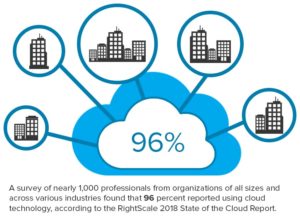
Businesses are increasingly choosing to devote their IT budgets to cloud-based offerings instead of traditional systems, creating a “cloud shift” effect that has a significant impact on all IT markets, according to Gartner. Investment in cloud solutions is expected to keep growing at a considerable pace.
For example, Gartner projects that enterprise IT spending on infrastructure as a service (IaaS) will increase from $39.5 billion this year to $63 billion through 2021.
Overall, cloud computing is “one of the most disruptive forces in IT markets since the early days of the digital age,” Gartner contributor Christy Pettey writes.
Regardless of the size of your business or the industry you’re in, staying on top of developments in the cloud space is crucial if you want to stay competitive and operate at maximum efficiency. Like the IT world overall, the cloud solutions market is constantly growing and changing. Here are a few notable cloud computing trends that you should keep an eye on as 2019 continues to unfold.
1. The growing popularity of serverless cloud solutions and services. Serverless computing is becoming increasingly common and will likely continue to gain popularity in 2019 and beyond. Essentially, going serverless involves asking for a container platform as a service (PaaS), according to the DATAVERSITY article “Cloud Architecture and Cloud Computing Trends in 2019.” Then your organization doesn’t have to worry about buying/renting or configuring servers.
It’s the fastest growing extended cloud service, showing a 75 percent year-over-year growth rate, according to RightScale’s 2018 survey. This method of cloud computing comes with certain advantages and disadvantages, DATAVERSITY states. On the plus side, you don’t need to invest the funds and time needed to purchase and set up servers. However, on the other hand, you might run into performance problems and limitations that you wouldn’t have otherwise.
2. Concern about cloud-related money management. The majority (76 percent) of respondents to RightScale’s survey identified managing cloud spend as one of their top challenges. Most organizations haven’t yet put automated policies (e.g., eliminating unused workloads) in place to optimize their cloud-related spending. Additionally, wasted funds are a significant issue: While survey respondents guessed that the amount of wasted spend was around 30 percent, it was actually 35 percent.
3. The imminent dominance of the hybrid multi-cloud approach. Because many companies that have migrated processes to the cloud still have critical workloads and data on-premise, they are expected to reject the “one cloud fits all” mindset in favor of a hybrid multi-cloud strategy, according to the IBM blog post “5 cloud predictions for 2019.”
Considering the best and most appropriate approach for each specific workload, businesses will likely leverage both public and private cloud solutions to maximize their ROI, IBM predicts. Hybrid cloud is expected to become the dominant approach since it lets users enjoy the benefits of both public and private cloud offerings.
For instance, a business can choose to keep operations involving sensitive data (e.g., financial info) on premises, while initiatives that don’t need as much security can move to the public cloud, according to DATAVERSITY.
4. More built-in cybersecurity for cloud solutions. Security measures used to get implemented after an app was already developed, according to IBM. However, now that cloud adoption has become widespread and organizations commonly juggle solutions from multiple vendors, the risk landscape has changed.
In 2019 and beyond, it’s anticipated that developers will include security early on in the process of creating an app, and DevSecOps culture will become part of the enterprise, IBM predicts.
5. New opportunities and problems related to 5G. In the next few years and beyond, 5G network deployment activity is expected to increase significantly. As these high-speed networks become available, they’ll create new opportunities in the cloud computing world, according to the Light Reading article “5G Will Transform the Enterprise Cloud.”
For example, 5G has the potential to drastically improve the cloud computing abilities of mobile devices. Additionally, businesses that currently don’t have high-speed internet access will be able to get low-latency, low-cost, fast connections with 5G, according to the InfoWorld article “5G will bring cloud computing to everyone.” That means organizations that currently can’t use cloud solutions due to lack of broadband will gain the ability to move to the cloud.
Overall, there’s a lot going on to keep an eye on in the cloud computing space in 2019 and beyond. If you have any questions about cloud solutions or services, our team of expert cloud consultants can help. We work with various cloud vendors in our partner network and can serve as your trusted in advisor in determining a cloud migration strategy and assessing which solutions would best meet your business’s specific needs. Connect with us today by calling 877-599-3999 or emailing sales@stratospherenetworks.com.


